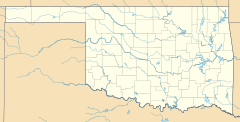Washunga, Oklahoma facts for kids
Quick facts for kids
Washunga, Oklahoma
|
|
|---|---|
| Country | United States |
| State | Oklahoma |
| County | Kay |
| Elevation | 1,024 ft (312 m) |
| Time zone | UTC-6 (Central (CST)) |
| • Summer (DST) | UTC-5 (CDT) |
| GNIS feature ID | 1099416 |
Washunga is a small community in Kay County, Oklahoma, United States. It is also known as a ghost town because most of its original buildings are gone. The community was named after a leader of the Kaw Native American tribe. His name, Washunga, means "bird" in the Kaw language. Sometimes, his name was spelled Washungah.
The town of Washunga began in 1903. It was built at the main office of the Kaw tribe, which was called the Kaw Agency. A post office opened at the Kaw Agency in 1880 and stayed open until 1918.
The building that used to be the Kaw Agency is now a special historical site. It is listed on the National Register of Historic Places (NRHP). In the early 1970s, this building was moved a short distance north. This was because the original spot was going to be covered by the waters of Kaw Lake.
Contents
History of Washunga and the Kaw People
The Kaw Tribe Moves to Oklahoma
In 1873, about 533 Kaw Native Americans moved from their old home in Kansas. They had a reservation near Council Grove, Kansas. But many white settlers were moving onto their land, making it hard for the Kaw people to live there. So, they moved to a new reservation in what is now Kay County, Oklahoma.
Their new land was very large, about 100,137 acres (40,524 hectares). It had some forests but was mostly tallgrass prairie. This area was part of the Flint Hills, which has rocky, hilly land. It wasn't great for farming, but it was perfect for grazing animals. The Kaw people bought this land from the Osage tribe. They used money from selling their old land in Kansas to pay for it.
Building the Kaw Agency Headquarters
The Kaw leaders chose a spot where the Arkansas River and Beaver Creek met. This became the headquarters for their reservation, known as the Kaw Agency. After a few years, this area had several important buildings:
- A mill for grinding grain and sawing wood.
- A school with a place for students to live.
- A barn.
- A post office.
- A home for the reservation's superintendent (the person in charge).
However, life was hard for the Kaw people in their new home. About half of them died between 1873 and 1879, mostly from sickness.
Changes to Kaw Land Ownership
In 1883, the Kaw people started to rent out some of their grazing land to white ranchers. This helped them earn some money, but it also meant they lost some control over their land.
Then, in 1903, the U.S. government made a big change. They used a law called the Dawes Act to end the Kaw Reservation. The tribe's land and money were divided among 247 registered members of the tribe. These members, called "allottees," could not sell their land for 25 years.
One famous person who received land was Charles Curtis. He was part Kaw and later became a Vice President of the United States. He received about 250 acres (101 hectares) of land about a mile north of Washunga.
The Town of Washunga Grows and Shrinks
In 1902, the community near the Kaw Agency was officially named Washunga. The Kaw Agency office stayed open until 1928. After that, many Kaw landowners sold the land they had received. By 1945, only a small part of the original reservation land was still owned by tribal members.
In the early 1900s, Washunga was a busy little town. It had:
- Grocery stores
- Gas stations
- A jail
- A pool hall
- Other businesses
- Its own city government
But by about 1950, most of these businesses were gone. Only the main school remained. The population of the area was only about 100 to 150 people. A nearby town called Kaw City, located across the Arkansas River, started to grow as Washunga became smaller.
Washunga Disappears Under Water
In 1976, the Kaw Lake was finished. This new lake covered the original site of Washunga with water. Because of this, the old Kaw Agency building had to be moved to higher ground. The Washunga cemetery was also moved to Newkirk, Oklahoma. Today, much of the original Washunga is underwater.





